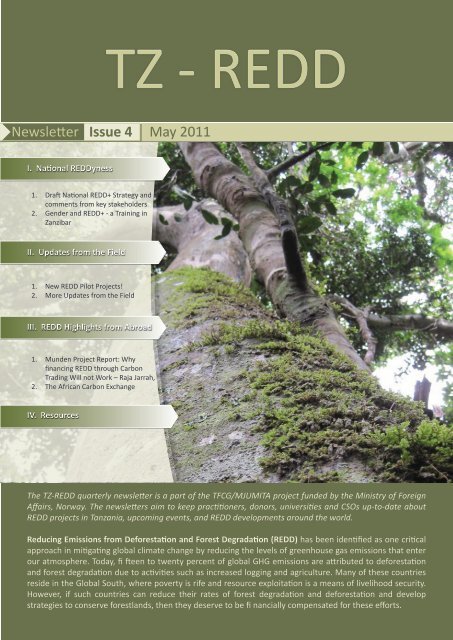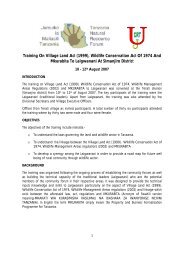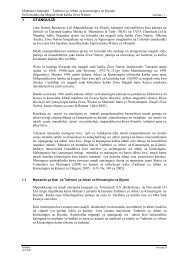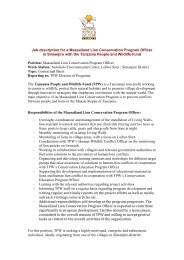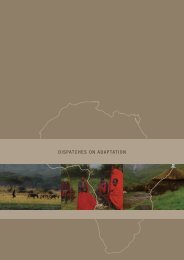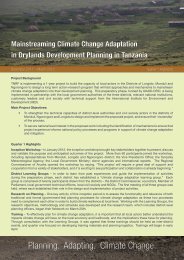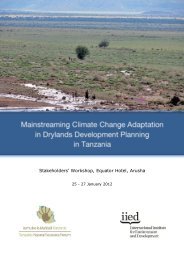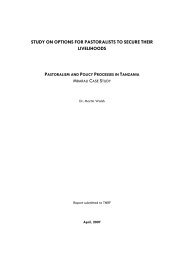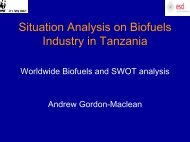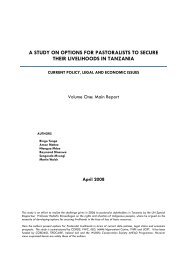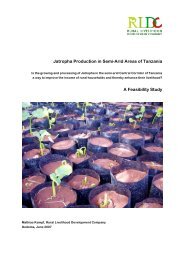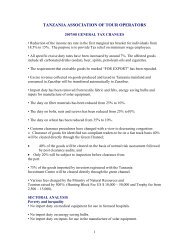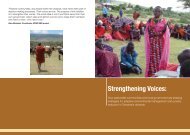here - Tanzania Natural Resource Forum
here - Tanzania Natural Resource Forum
here - Tanzania Natural Resource Forum
- No tags were found...
You also want an ePaper? Increase the reach of your titles
YUMPU automatically turns print PDFs into web optimized ePapers that Google loves.
General Comments<br />
Each set of comments begins with overall<br />
feedback on the Strategy. All three stakeholder<br />
groups praise the work of the Task Force<br />
for producing a relatively comprehensive<br />
Strategy that will serve as an important step in<br />
the REDD implementation process. While the<br />
three sets of general, or ‘overall,’ comments<br />
vary in focus and specificity, t<strong>here</strong> are some<br />
recommendations overlapped between the<br />
three stakeholder groups.<br />
The REDD pilot projects suggest that the<br />
document is too long, containing information<br />
that isn’t directly relevant to strategic<br />
implementation, which instead “buries” some<br />
important key issues, such as community<br />
carbon rights and management of REDD<br />
funds. DPG-E points to the same problem;<br />
however, they point out that generality “is<br />
arguably very appropriate at this stage of<br />
REDD+ development when many of the key<br />
challenges…have just begun to be identified”<br />
(DPG-E, 1). However, both agree that the<br />
lengthy background might not be necessary<br />
to serve as the entire document, and DPG-E<br />
suggest it come as an Annex.<br />
All three stakeholder groups agree that<br />
the timeframes provided needs to be<br />
more clear and more realistic. UN-REDD<br />
suggests that a clearer timeframe will help<br />
involve more stakeholders; DPG-E suggests<br />
that separating short-term and long-term<br />
indicators might help, and that some tasks<br />
and strategic activities will take longer than a<br />
2012 framework; and the REDD pilot groups<br />
comment that “some of the time frames are<br />
unrealistic for the tasks at hand, and some<br />
of the information is outdated” (REDD Pilots,<br />
pg. 1).<br />
As mentioned, UN-REDD strongly encourages<br />
broadening stakeholder involvement by<br />
expanding the National REDD Task Force to<br />
include members from additional government<br />
bodies, such as the Ministry of Agriculture<br />
and Food Security and the Ministry of Energy<br />
and <strong>Resource</strong>s, as well representatives from<br />
civil society, including NGOs and members<br />
of forest dependent communities. The<br />
REDD Pilot Projects share a similar opinion,<br />
suggesting that “the time has come for civil<br />
society to participate fully in the process of<br />
designing and developing REDD mechanisms<br />
from now on” (REDD Pilots, pg. 2). DPG-E’s<br />
point out that the Strategy acknowledges the<br />
need to broaden consultations beyond the<br />
current Task Force; however, it does not feel<br />
that the Strategy adequately addresses how<br />
REDD strategic options will “be mainstreamed<br />
within sector programmes and expenditure<br />
frameworks,” and how it will be well linked<br />
to other initiatives like MKUKUTA. UN-REDD<br />
shares this same concern.<br />
Finally, both DPG-E and the REDD pilot<br />
projects note that social and environmental<br />
safeguards are missing as a key result area,<br />
and that this could be the focus of a new KRA.<br />
Specific Comments on the Key Result Areas:<br />
Each set of comments provided specific<br />
recommendations or suggestions for each<br />
key result area. The following is a general<br />
overview of these comments:<br />
Key Result Area 1: REDD+ baseline scenario,<br />
monitoring, reporting and verification<br />
framework established<br />
• It is not clear how the National Carbon<br />
Accounting System (NCAST) is linked<br />
with the NAFORMA system (UN-REDD),<br />
and it should be made more clear how<br />
the National Carbon Monitoring Centre<br />
(NCMC) will play a role in MRV (DPG-E).<br />
• T<strong>here</strong> is no mention of MRV for social and<br />
environmental safeguards and outcomes,<br />
and this should be incorporated into this<br />
section (REDD pilot projects).<br />
3
Key Result Area 2: Financial mechanisms and<br />
incentive schemes established<br />
• All suggest that KRA 2 & 5 would benefit<br />
from being merged together<br />
• All financial options should to be explored<br />
(UN-REDD). The document appears<br />
to favor a carbon Trust Fund as the<br />
preferred mechanism, but t<strong>here</strong> isn’t<br />
sufficient justification for selecting such<br />
a mechanism (DPG-E). If a Trust Fund is<br />
the selected mechanism, it needs to be<br />
stated “clearly and unambiguously in the<br />
rationale’ (REDD pilot projects).<br />
Key Result Area 3: All Stakeholders are<br />
engaged in the REDD+ implementation<br />
process<br />
• All agree with this, and encourage more<br />
elaboration and inclusion of a broader<br />
group of stakeholders<br />
Key Result Area 4: “All REDD+ schemes are<br />
well coordinated”<br />
• Conflict resolution is mentioned in the<br />
KRA, but it is not well defined and it could<br />
benefit from additional clarification and<br />
more concrete details of what it means<br />
and how it would work (UN-REDD/REDD<br />
pilot projects)<br />
• It might be beneficial to mention subnational<br />
or ‘nest’ approach and an overall<br />
system for coordination (DPG-E/UN-REDD)<br />
Key Result Area 5: “All carbon market<br />
options are well understood/All fund based<br />
financing options are well understood”<br />
• KRA 5 and 2 could be combined (all)<br />
• This KRA would benefit from a proposal<br />
on how decisions will be taken, by whom,<br />
etc. (REDD pilot projects), and cover<br />
voluntary markets as well as include “a<br />
strategic activity under this KRA would<br />
be to identify and remove bottlenecks to<br />
accessing carbon funding” (DPG-E)<br />
Key Result Area 6: Governance mechanism<br />
for REDD+ in place<br />
• The “Legal and institutional Framework<br />
review in the context of REDD+<br />
intervention” is one study that has<br />
already taken place, but this KRA does<br />
not incorporate the results of this study.<br />
Instead, it is suggested that this study that<br />
has already been conducted can provide<br />
clear direction on legal issues for REDD+<br />
(DPG-E/UN-REDD)<br />
• The concept of ‘governance’ could use<br />
better clarification (REDD pilot projects/<br />
UN-REDD)<br />
Key Result Area 7: Training programme and<br />
infrastructure for REDD+ Developed<br />
• T<strong>here</strong> is overlap between this KRA and<br />
others, as training is mentioned in other<br />
KRAs. It is recommended that this KRA can<br />
be consolidated with other KRAs (DPG-E)<br />
or that training and capacity building is<br />
left to this KRA only (REDD pilot projects)<br />
Key Result Area 8: Current knowledge<br />
and scientific understanding of the target<br />
forests and adjacent communities improved<br />
through research<br />
• T<strong>here</strong> should be a stronger link to the<br />
Climate Change Impacts Adaptation<br />
Mitigation program (UN-REDD/DPG-E)<br />
• By listing research areas prior to carrying<br />
out the actual research assessment needs,<br />
prejudges the importance of certain areas<br />
and could potentially give them special<br />
status before a review is carried out (REDD<br />
pilot projects)<br />
Key Result Area 9: An effective information<br />
and knowledge communication system on<br />
REDD+ issues developed<br />
• This KRA seems to focus on education and<br />
communications more than information<br />
management (DPG-E)<br />
• Many points and activities under this KRA<br />
might benefit from being placed within<br />
4
other KRAs, as “it is unlikely a single<br />
system” will address all the specific needs<br />
(REDD pilot projects)<br />
Key Result Area 10: REDD+ strategy options<br />
for addressing drivers of D&D developed<br />
• “Adopt a more strategic objective geared<br />
towards addressing the key drivers of<br />
deforestation rather than simply to<br />
‘develop strategic options’” (REDD pilot<br />
projects)<br />
• T<strong>here</strong> is a very broad list, containing<br />
many elements of a long term program.<br />
It is recommended that these actions are<br />
prioritized for the next phase of strategy<br />
development (DPG-E)<br />
Read all comments <strong>here</strong>:<br />
DPG-E & NORAD: http://www.tnrf.org/files/<br />
DPG-E%20feedback%20to%20REDD%20<br />
strategy%20draft.pdf<br />
UN-REDD Program: http://www.tnrf.org/<br />
files/UNREDD-T_Comments%20on%20<br />
Draft%20National%20REDD%20Strategy.pdf<br />
REDD Pilot Projects: http://www.tnrf.<br />
org/files/FEEDBACK%20First%20Draft%20<br />
National%20REDD%20Strategy%20from%20<br />
REDD%20Pilot%20Projects.pdf<br />
2. Gender and REDD+ - a Training in Zanzibar<br />
Submitted by CARE/HIMA project<br />
REDD Pilot Projects met in Zanzibar for three<br />
days in April to take the lid off that box called<br />
“Gender,” which it seems has been hidden<br />
somew<strong>here</strong> in most REDD project designs. The<br />
Gender and REDD Training Workshop, hosted<br />
by CARE/HIMA, brought together 30 trainees<br />
from seven pilot projects and representatives<br />
of HIMA’s project partners. Led by facilitators<br />
Catherine Hill (international) and Emma<br />
Liwenga (<strong>Tanzania</strong>, IRA), the group covered<br />
topics ranging from “what is mainstreaming<br />
gender” to “influencing national policy,”<br />
via everything in between! Covering such a<br />
wide scope in only three days is limiting, and<br />
t<strong>here</strong>fore we could only scratch the surface<br />
of some of these subjects; however, it was<br />
helpful in setting the agenda for participants<br />
of what they might do next in their own<br />
projects.<br />
Key learning points that the workshop<br />
highlighted:<br />
• Gender relations are a social creation, one<br />
that is made up by humans and can be<br />
changed by humans<br />
• Mainstreaming gender means integrating<br />
this understanding into everything we do<br />
• While REDD and REDD+ are about carbon,<br />
both have livelihoods and gender impacts<br />
• The reason that we target women’s<br />
empowerment is that men are already in<br />
a more privileged position, t<strong>here</strong>fore to<br />
achieve equality, we must focus on women<br />
• Women’s empowerment tools can help us<br />
look more deeply at what we do in REDD<br />
projects in relation to gender<br />
• We also need tools for working with both<br />
women and men, because both genders<br />
have to cooperate and support change<br />
The workshop considered three areas w<strong>here</strong><br />
REDD poses a risk to gender equity:<br />
• Forest management - by denying women’s<br />
access to forest resources, including land<br />
for subsistence agriculture<br />
• Land tenure - in a situation w<strong>here</strong><br />
customary rights commonly over-ride legal<br />
rights, women’s entitlement to benefits of<br />
REDD is at risk<br />
• Forest governance - the challenges of<br />
meaningful participation and ensuring<br />
transparency and accountability of those<br />
involved in the managing REDD<br />
5
Evidently, many of these risks are neither<br />
gender-specific nor confined to REDD, though<br />
this does not diminish the need to address<br />
them robustly in REDD projects. An area noted<br />
by participants that we did not have time to<br />
explore is how to deal with the inevitable<br />
conflicts that will arise under REDD.<br />
When we looked at establishing good<br />
practice on gender reporting and monitoring<br />
indicators, we realised from our collective<br />
discussion that the field of Gender and REDD<br />
is a relatively new one. We are all learning<br />
together, and while we can draw from<br />
experience in related areas, t<strong>here</strong> is little<br />
specific guidance to work from. An illustration<br />
of this is that the CCB standards, which most<br />
REDD pilots are working towards, are actually<br />
very weak on gender.<br />
Each project came up with a few next steps,<br />
including carrying out an internal “gender<br />
health check” of all project components,<br />
developing a project-based gender strategy,<br />
developing guidelines on REDD benefit<br />
sharing, and training and capacity building<br />
for our staff and other. It was also noted that<br />
as the National REDD Task Force establishes<br />
its Technical Working Groups, t<strong>here</strong> are<br />
opportunities to incorporate gender in several<br />
different ways.<br />
Finally, many participants expressed a desire<br />
to keep up the momentum that had been<br />
built up in this workshop. T<strong>here</strong> is a long way<br />
to go and this initial workshop was just the<br />
beginning. To help us go forward, the idea<br />
of a REDD & Gender Learning Network was<br />
suggested, and a small group from CARE and<br />
TFCG volunteered to explore how to set this<br />
up. Stay tuned for more information!<br />
PowerPoint Presentation:<br />
http://goo.gl/3H8o6<br />
II. Updates from the Field<br />
1. New REDD Pilot Projects!<br />
At the start of this year, two new REDD projects funded by the Norwegian Ministry of Foreign<br />
Affairs (MFA) were formally launched. The following is an in-depth overview of the two new<br />
projects.<br />
1. World Wildlife Fund’s (WWF) “Enhancing <strong>Tanzania</strong>n Capacity to Deliver Short and Long<br />
Term Data on Forest Carbon Stocks Across the Country”<br />
Submitted by WWF<br />
The WWF REDD Project aims to contribute to the establishment of the national <strong>Tanzania</strong>n<br />
carbon trading system, established to reduce GHG emissions from the deforestation and<br />
degradation of <strong>Tanzania</strong>n forests, t<strong>here</strong>by slowing climate change. Specifically, it will carry<br />
out the following activities:<br />
• Establishment of baseline carbon plots and their measurements in different vegetation/<br />
cover types building on work that has been initiated by the collaborating institutions in<br />
the Eastern Arc Mountains and expanding this network of field plots to cover additional<br />
6
habitat types and geographical regions<br />
of <strong>Tanzania</strong> to enable more accurate<br />
estimates of carbon stocks in different<br />
cover types, including coastal forests,<br />
miombo woodlands, acacia savanna,<br />
grasslands and wetlands. WWF will choose<br />
degraded, degrading and intact forests to<br />
be able to estimate carbon lost through<br />
forest degradation process. Approximately<br />
120 permanent plots will be established in<br />
12 different vegetation types in different<br />
geographic regions.<br />
• Completing hemispherical photographic<br />
surveys of vegetation structure within<br />
each of the 120 plots. These data comprise<br />
both information used for the modeling<br />
component on the project, such as satellite<br />
derived moisture distribution (TRMM),<br />
and direct remotely sensed vegetation<br />
products such as SPOT, KOMPSAT, Landsat,<br />
Quickbird.<br />
• Commissioning LiDar overflights as an<br />
addition to the Norwegian government<br />
funded LiDar project. These additional<br />
overflights will cover at least 18 of the<br />
plots, including those with hemispherical<br />
photographs and other ground based<br />
measurements of forest structure. These<br />
overflights will allow some detailed<br />
comparative statistics to be developed<br />
in lowland and montane regions, testing<br />
out the utility of the LiDar approach for<br />
potential further expansion as a sampling<br />
strategy at national scale.<br />
• Assessing soil carbon within each of the<br />
120 plots, at various points within each<br />
plot. A professional quality soil carbon<br />
analyzer is included in the budget and will<br />
be used to analyze the samples collected<br />
from the field.<br />
• Mapping future carbon scenarios, which<br />
will be a major additional value to the<br />
existing MRV projects in <strong>Tanzania</strong>. The<br />
current land use base map and available<br />
carbon data will be manipulated in GIS to<br />
develop future land use change scenarios<br />
to 2025/2050 - based on potential<br />
changes in land cover across the entire<br />
country according to a business as usual<br />
and a more hopeful environmental future<br />
of <strong>Tanzania</strong>n development. With the<br />
established link between the plots and<br />
the present climatic and environmental<br />
regime part of the scenario mapping WWF<br />
will investigate the impacts of climate<br />
change by substituting present day climate<br />
for future climate available from regional<br />
climate modeling expertise on East Africa<br />
available through the climate production<br />
Center at the Kenyan Meteorological<br />
Office (ICPAC) and the Hadley Center UK<br />
as t<strong>here</strong> is an increasing regional climate<br />
model focus in the lead up to the next<br />
IPCC report 2015.<br />
• Providing training and building capacity<br />
at <strong>Tanzania</strong>n national level. Experience<br />
from Valuing the Arc, and during the<br />
development of this project, has shown<br />
that t<strong>here</strong> is a need for further capacity<br />
building in modeling aspects of forest<br />
carbon, land use change, climate change<br />
and scenario mapping work. Training in<br />
modeling approaches will be provided<br />
by experts from the project team in York<br />
University to collaborators in Sokoine<br />
University of Agriculture.<br />
These analyses are expected to provide<br />
rigorous measurements of carbon accounting<br />
that will be an essential input into the REDD<br />
process in <strong>Tanzania</strong>, both in the inception and<br />
the subsequent evolution as the extensive<br />
network of plots can be re-measured and<br />
monitored as a barometer of the impact of<br />
changing carbon capital in <strong>Tanzania</strong>. The WWF<br />
REDD project will manage the data derived<br />
from carbon plots within a database held at<br />
WWF-TCO, Sokoine and York Universities.<br />
This database will be shared with NAFORMA<br />
and UN REDD prorgrammes within FBD to<br />
inform the development of a MRV system<br />
and forest carbon baseline for the country.<br />
7
Carbon Baseline plots:<br />
Plots will be implemented in the following places:<br />
Cover Type Number of Plots Remarks<br />
Miombo<br />
Woodlands<br />
Acacia/Commiphora<br />
Woodlands<br />
40 Most extensive and diverse cover type, less studied with respect to<br />
carbon, higher potential for degradation through utilization. Possible<br />
sites in Iringa/Mbeya to include old growth and regenerating miombo<br />
stands. Particularly responsive to carbon sequestration under<br />
climate change scenarios.<br />
10 An important cover type though not very widespread, no data on<br />
this type, high potential for degradation through utilization. Possible<br />
sites include the Somali-Masai regional center of endemism<br />
in Arusha, Dodoma and Mwanga. Particularly responsive to carbon<br />
sequestration under climate change scenarios.<br />
Coastal Forests 25 Widespread and diverse, less studied with respect to carbon, includes<br />
woodlands in parts. Possible sites include Matumbi/Kichi Hills<br />
and selected parts in Kilwa and Coast regions<br />
Grasslands 10 Extensive, different types – upland, savannah, and flood plains.<br />
Poorly studied/poor knowledge on their carbon content but big potential<br />
especially in the soils in floodplains. High potential for degradation<br />
through overgrazing and cultivation. Possible sites include the<br />
Kilombero Valley Flood plains, High Altitude grasslands in the Eastern<br />
Arc and the southern highlands region – Mufindi, and savannah<br />
grasslands in Iringa/Mbeya<br />
Bushlands and<br />
Thickets<br />
10 Not very extensive, poorly studied with respect to carbon – poor<br />
knowledge on its carbon storage potential. Potential areas include<br />
selected parts of the Somali-Masai regional Centre of Endemism,<br />
and Itigi thickets<br />
Mangroves 5 A specific cover type, no information on their potential for carbon<br />
storage, high potential for degradation through utilization. Potential<br />
sites in Rufiji and Kilwa with the former being particularly extensive.<br />
Very important area in the context of predicted sea-level change<br />
Forests 20 Some knowledge on carbon storage potential though inadequate,<br />
forests on volcanic mountains poorly studies, more plots on the volcanic<br />
mountains of Rungwe, Hanang and the Eastern Arc Mountains<br />
w<strong>here</strong> information is lacking (Uluguru, East/West Usambara, South/<br />
North Pare)<br />
Total 120<br />
8
Project Background:<br />
Professor Shadrack Mwakalila<br />
Coordinator of WWF’s REDD Project<br />
The WWF REDD project is coordinated by<br />
WWF <strong>Tanzania</strong> country Office, under Professor<br />
Shadrack Mwakalila, under the Valuing the<br />
Arc Program, which has been mapping,<br />
modeling and valuing ecosystem services<br />
across the eastern part of the country. Prof.<br />
Mwakalila has been coordinating the Valuing<br />
the Arc Programme in WWF <strong>Tanzania</strong> since<br />
2007 to date.<br />
2. WCST Piloting REDD in Pugu Kazimzumbwi<br />
Forest Reserves<br />
By Mr. Lota Melamari<br />
Going by the saying that “it is better late than<br />
never,” WCST had waited patiently to sign a<br />
contract between the Norwegian Ministry of<br />
Foreign Affairs (MFA) and WCST, which meant<br />
approval of the last out of nine Piloting REDD<br />
projects in <strong>Tanzania</strong>. The WCST project is<br />
known as Piloting REDD in Pugu Kazimzumbwi<br />
Forest Reserves or “Hifadhi Mapafu ya Dar Es<br />
Salaam” (HIMADA).<br />
The Project will operate in Pugu and<br />
Kazimzumbwi National Forest Reserves,<br />
which have eight adjacent villages serving as<br />
the basic operational areas. In addition, the<br />
project will work in Kisanga Village Forest<br />
Reserves in Kisarawe and support greening of<br />
planned areas in Ilala District. Both Pugu and<br />
Kazimzumbwi Forest Reserves have suffered<br />
considerably from deforestation and forest<br />
degradation. Although these challenges can<br />
slow down processes and progress, they<br />
do present excellent lessons learned on the<br />
complexities of land tenure.<br />
The overseers of the project include the<br />
National REDD Task Force, The Embassy<br />
of Norway and the Institute of <strong>Resource</strong><br />
Assessment. Thus the HIMADA project, just<br />
like other REDD Piloting projects, enters into<br />
implementation through a multi-faceted and<br />
multi-stakeholder participatory initiative<br />
to improve forest management and reduce<br />
Carbon emissions through deforestation and<br />
forest degradation.<br />
Activities<br />
This project will be implemented in two<br />
phases. The first phase being an inception,<br />
preparatory and mobilization phase, while<br />
the second will focus more on the full<br />
implementation. The delivery in phase one<br />
will set the basis for phase two. By ensuring<br />
that issues related to: governance, legal<br />
and institution; awareness and knowledge<br />
management; stakeholders analysis;<br />
surveying of forest borders; strengthening<br />
of patrols and establishment of project<br />
infrastructure are addressed.<br />
The establishment of a baseline for measuring<br />
of carbon stocks in the forest (locating<br />
permanent sample plots) and carrying out<br />
activities to quantify drivers of deforestation<br />
is one of the main project activities (the<br />
main drivers currently identified as being<br />
abstraction of timber, fabrication of charcoal,<br />
agriculture and uncontrolled fires). Once the<br />
studies are done, it will be possible to address<br />
the drivers of deforestation and estimating<br />
carbon losses from different causes. Results<br />
will also help inform a plan to understand and<br />
combat leakage, as well as identify areas to<br />
focus on the conservation of the forests.<br />
9
The project addresses issues of PFM and livelihood strategies to be gained through improved<br />
management of the two Forest Reserves over a period of four years, an overwhelming<br />
adaptation to climate change through the delivery of five outputs. Additionally, special<br />
consideration will be given to public awareness raising through communications, training and<br />
willingness to work with civil society to pave a way for progress and sustainable conservation.<br />
T<strong>here</strong> is a need to promote good and build good working relationship among all the actors<br />
through good dialogue and creating opportunities for real participation<br />
Key Aspects of the Project<br />
• The project will operate through strategic partnerships. The design of the project has given<br />
room for WCST to outsource competencies by entering into sub-contracts with partner<br />
organizations that will deliver some of the outputs. WCST will enter into sub-contracts<br />
with four Institutions including: EMNET, Sokoine University of Agriculture - Faculty of<br />
Forestry ad Nature Conservation, LEAT and UDBS. Each one of the partners will provide<br />
technical support to their respective areas of expertise along with coordinating linkages<br />
with others.<br />
• The project will apply a Participatory Forest Management (PFM) approach together with<br />
Joint Forest Management (JFM) and Community Based Forest Management (CBFM)<br />
mechanisms for forest management regimes for applying REDD in the forest areas. Support<br />
to tree planting and greening of areas bordering forests will jointly be done with Local<br />
Government Authorities in Kisarawe and Ilala districts.<br />
• This project has yet another unique feature in that is intended to address elements of<br />
ownership and sustainability through the creation of a fund to be known as The Pugu<br />
Kazimzumbwi Forest Reserve Fund (PKFRF). This will be created for the purpose of<br />
financing JFM activities, as well as provision of a sustainable working capital for community<br />
entrepreneurship groups like beekeeping, mushroom and hand crafts groups in the village.<br />
The project will facilitate the formation of savings and credit societies like SACCOS and<br />
VICOBA to that effect.<br />
2. More Updates from the Field<br />
1. Update on AWF-led pilot REDD project in north-central <strong>Tanzania</strong><br />
Submitted by AWF<br />
The main goal of the project is two-fold:<br />
climate change mitigation and poverty<br />
reduction. Being a REDD readiness initiative,<br />
the purpose of the project is to prepare<br />
the targeted local communities and local<br />
government in Kondoa to enter carbon<br />
trading successfully. The intermediate results<br />
of the project include carbon assessment,<br />
capacity building on REDD, land and forest<br />
management, diversification of community<br />
livelihood options and improvement policy<br />
and practice through learning and networking.<br />
Progress in 2011<br />
• Carbon qualification process and first<br />
event of carbon quantification have been<br />
completed<br />
• 23 men and 5 women have been trained<br />
as REDD trainers<br />
• Sixty lead farmers provided theoretical<br />
and practical training on environmentally<br />
sound agricultural practices, each with a<br />
demonstration farm and farm inputs<br />
• Knowledge and experiences, including<br />
challenges and lessons have been shared<br />
10
widely through various forums<br />
• Village Land Use Planning (LUP) has<br />
started in five villages, so far approved by<br />
their legal organs (Village Governments<br />
and Village General Assemblies)<br />
• Joint Forest Management (JFM)<br />
process has started around two existing<br />
government forest reserves<br />
Current challenges<br />
• ARKFor is one of a few if not the only<br />
pilot REDD project in the country that is<br />
involved with JFM (about 46% of target<br />
forests are government forest reserves).<br />
T<strong>here</strong>fore, it has a very important role of<br />
demonstrating how REDD can work under<br />
JFM. The challenge is whether the share of<br />
cash benefit (especially the REDD money)<br />
will satisfy communities members. AWF<br />
anticipates that the government will<br />
accept the request of allocating all or over<br />
80% of JFM REDD money to communities<br />
in return of their conservation and forest<br />
management efforts.<br />
• Despite extensive explanation and<br />
awareness, a considerable number of<br />
local communities are confused about the<br />
distinction between AWF and TANAPA,<br />
hence fearing that the current JFM move<br />
will ultimately hand the forest to TANAPA,<br />
thus losing control and access to the<br />
forest. They further fear that TANAPA<br />
will promote the introduction of lions,<br />
leopards and other dangerous animals<br />
that will jeopardize their lives.<br />
• Inter-village boundary disputes have been<br />
slowing the speed of land use planning<br />
process in some villages. However, the<br />
government has been addressing this<br />
challenge effectively.<br />
• AWF is still struggling to raise additional<br />
funding (about $500,000) to accommodate<br />
the increment of project scope as<br />
recommended by the feasibility study,<br />
which suggested increasing the project<br />
area from 18,000 ha to 56,000 ha and<br />
project villages from 15 to 21.<br />
• For more information:<br />
skiruswa@awfafrica.org<br />
2. CARE HIMA REDD project in Zanibar<br />
Submitted by CARE HIMA project<br />
The HIMA project in Zanzibar is drawing towards the end of its one-year inception phase. Key<br />
achievements in the past year have been the mapping of forty community forest management<br />
areas on the islands of Unguja and Pemba; implementation of new guidelines on how to<br />
develop community forest management agreements; the completion of the carbon feasibility<br />
study that establishes the orders of magnitude of REDD in the project; and the expansion of<br />
tree nurseries to allow for increased planting of woodlots, as well as piloting a scheme to<br />
reduce charcoal consumption by encouraging the adoption of LPG (bottled gas).<br />
A great deal of effort has been expended in the first year on data collection for both carbon<br />
measurement as well as social impact. Some of this will continue into year two, particularly<br />
the detailed measurement of biomass in sample plots across the islands. Perhaps the biggest<br />
lesson learned so far is that data collection for carbon monitoring for REDD is extremely<br />
labour-intensive compared to the monitoring and evaluation demands of normal projects.<br />
11
The task for the year ahead is to identify and<br />
build the capacity of an institution that will<br />
act as an aggregator of the carbon credits<br />
from the different communities, as well as<br />
to ensure that mechanisms are in place at<br />
community level to ensure that REDD has a<br />
positive social impact and that benefits are<br />
equitably shared between men and women<br />
as well as with poorer households.<br />
3. Update from TFCG and MJUMITA<br />
By Bettie Luwuge, Project Manager<br />
The project ‘Making REDD work for<br />
communities and Forest Conservation<br />
in <strong>Tanzania</strong>’ aims to reduce greenhouse<br />
gas emissions from deforestation and<br />
forest degradation in <strong>Tanzania</strong> in ways that<br />
provide direct and equitable incentives to<br />
communities to conserve and manage their<br />
forests sustainably. The project has assisted<br />
26 villages (13 in Lindi and 13 in Kilosa) to<br />
develop participatory strategies to reduce<br />
deforestation and forest degradation and<br />
improve livelihoods. These strategies form<br />
the basis for the activities that are now<br />
being undertaken by the project to support<br />
communities to reduce deforestation in a<br />
pro-poor way.<br />
As part of the implementation of these<br />
strategies, so far the following has been done:<br />
• 4 villages have demarcated village forest<br />
reserves and prepared management<br />
plans and by-laws covering 4628 ha in<br />
Kilosa and 1873 ha in Lindi.<br />
• 13 village resolved long-standing<br />
boundary conflicts;<br />
• Six villages, with a population of 10,710,<br />
have prepared village land use plans;<br />
• A social impact assessment has been<br />
carried out for the Lindi site; and<br />
• 46 teachers have been trained in<br />
environmental education.<br />
The project has also made progress towards<br />
the development of a project design<br />
document for the Voluntary Carbon Standard.<br />
Over the last six months their remote sensing<br />
team has been carefully analysing Landsat 5,<br />
SPOT and PALSAR images and carrying out<br />
ground-truthing in order to develop landcover<br />
classifications for the two sites and their<br />
reference regions. The team have faced and<br />
overcome various technical hurdles including<br />
dealing with cloud cover and shadow in the<br />
images; seasonal changes in vegetation; and<br />
distinguishing between forest and fallow<br />
areas. Classification of both landscapes has<br />
now been completed.<br />
Villagers in Ruhoma Village in Lindi getting<br />
practical knowledge of assessing carbon.<br />
Villagers being informed about REDD activities<br />
in TFCG/MJUMITA project.<br />
Learn more about the project <strong>here</strong>:<br />
http://www.tfcg.org/makingReddWork.html<br />
12
4. MCDI REDD Project Update<br />
Submitted by MCDI<br />
The Mpingo Conservation and Development<br />
Initiative (MCDI) is using its extensive<br />
experience with PFM in Southeast <strong>Tanzania</strong><br />
to implement a REDD project in Kilwa District.<br />
Working with strategic partners, the project<br />
has carried out many activities so far, such<br />
as a review of the drivers of deforestation,<br />
laying baseline for measurement of carbon<br />
stocks in forest and trialing methods for<br />
monitoring socio-economic impacts of REDD<br />
in the project villages. Specifically, MCDI has<br />
more recently carried out the following:<br />
• MCDI has signed contracts with 5<br />
villages, which will be involved in the<br />
implementation of the REDD pilot<br />
project<br />
• Established 15 permanent sample plots<br />
for carbon measurement<br />
• Carried out preliminary estimates for<br />
carbon lost through different drivers of<br />
deforestation in Kilwa<br />
• MCDI has produced a Leakage<br />
Mitigation Strategies Scoping report<br />
• Socio-economic monitoring methods<br />
designed, trialed and refined<br />
• An ongoing policy analysis has been<br />
updated<br />
III. REDD Highlights from Abroad<br />
1. Munden Project Report: Why financing REDD through Carbon Trading Will not Work<br />
Comment piece by Raja Jarrah, REDD Technical Adviser<br />
HIMA REDD Pilot Project, CARE Zanzibar<br />
In March, an important report on REDD was released quietly on the internet. The report is<br />
from the Munden Project, experts in market trading systems, and looks at the prospects for<br />
a carbon market to actually achieve the objectives of REDD – to benefit people by mitigating<br />
climate change and saving forests. Perhaps the reason it has not (yet) received much publicity<br />
is that, despite excellent efforts by the authors to make it concise and not too technical, it<br />
still seems dense if you are not familiar with market-trader jargon—“derivatives,” “over the<br />
counter trading” and “counterparty clearing”. Perhaps another reason is that it makes gloomy<br />
reading for those who hope that a carbon market for REDD is around the corner.<br />
In sum, the Munden Project report explains why financing REDD through carbon trading will<br />
not work. However, this is not the market-bashing, anti-private sector argument sometimes<br />
used by opponents of REDD. In fact, the authors are commodity trading specialists, and they<br />
stand to gain from a working REDD carbon market. They do not take issue with using REDD to<br />
offset industrial emissions, which is the basis of most critiques of the market. Their analysis<br />
is technical, and their critique is based on how market trading in forest carbon credits might<br />
or might not work in practice. They conclude, “….the current mechanism for engaging private<br />
capital under REDD – the so-called ‘market’ approach – is highly likely to fail. Forest carbon<br />
trading is unworkable as currently constructed.”<br />
REDD carbon is a virtual commodity, rather than a physical one. While trees and the carbon in<br />
them exist, what you are actually trading in REDD is an act of faith – faith that the carbon would<br />
not have been captured otherwise, and faith that it will continue to be in future. This in itself<br />
13
is not a problem as most commodity trading<br />
is based on trading promises – promises to<br />
deliver and promises to pay. The system only<br />
works if it is regulated to ensure that those<br />
promises are kept most of the time. The<br />
difference with REDD is that it does not have<br />
the basic ingredients to make a regulatory<br />
system work, and this will severely restrict the<br />
free flow of private sector resources towards<br />
forests. In short, forest carbon is too risky to<br />
make reliable trade.<br />
Reasons for this include<br />
• Forest carbon is defined in an imprecise<br />
and variable way from place to place. This<br />
makes it a risky commodity with nonuniform<br />
quality and unpredictable supply<br />
and demand. In such circumstances<br />
commodity traders will either steer clear<br />
of it completely, or drive the price down to<br />
cover their risk.<br />
• The demands to count carbon to very high<br />
standards can only be met by relatively few<br />
specialised service providers, which limits<br />
the sources that commodity traders will be<br />
able to use to spread risk (for example of<br />
default by one supplier). This favours the<br />
consolidation of REDD carbon business<br />
in the hands of a small number of large<br />
traders, making it a buyers’ market; again,<br />
this will drive down prices and lower the<br />
share of funds for projects on the ground<br />
• Too many resources are required to<br />
measure, validate and verify carbon in<br />
the majority of cases. If REDD matures<br />
towards a typical commodity market,<br />
w<strong>here</strong> perhaps 5% of the final price makes<br />
it to the producer, very few forests will<br />
be able to sustain the transaction costs<br />
of marketing carbon and benefit local<br />
communities.<br />
The overall conclusion is that if REDD depends<br />
largely on a commodity-style market, it<br />
will fail to generate the income for projects<br />
that is needed to provide the incentives<br />
and the benefits for forest communities.<br />
Once disillusion sets in, the risk to a return<br />
to previous levels of deforestation and<br />
degradation is very real.<br />
The authors predict two broad outcomes if<br />
REDD follows the present track. One is that<br />
REDD will be restricted to only a few special<br />
circumstances, and largely abandoned<br />
by most governments once the phase of<br />
concessionary funding is over. The second<br />
possibility, which has various permutations,<br />
is some form of carbon market failure,<br />
including a loosening of standards as market<br />
actors learn to exploit all the loopholes in the<br />
system and create “junk REDD” – i.e. carbon<br />
credits that somehow obey the letter of the<br />
(imperfect) rules, but do not actually lead to<br />
any additional climate or community benefit.<br />
The report draws a parallel with recent<br />
experience of the financial markets, w<strong>here</strong><br />
sub-prime lending led to a crash and the need<br />
for government bail-outs. In the case of REDD,<br />
the consequences could be disastrous for<br />
forests: bursting the REDD bubble could lead<br />
to a cash flow crisis that governments meet<br />
by “leveraging their most readily available<br />
and marketable asset: forest timber.”<br />
The report concludes with some tentative<br />
recommendations, which should come as little<br />
surprise to those working on the pilot REDD<br />
projects in <strong>Tanzania</strong> – what is interesting is<br />
that they reach these conclusions by coming<br />
at the problem from a completely different<br />
direction.<br />
1. For any REDD financing to work, a project<br />
producing carbon must have the right to<br />
exist and operate on the land. T<strong>here</strong>fore,<br />
land tenure is a critical prerequisite – not<br />
just a secondary consideration.<br />
2. Simplify the definition of forest carbon,<br />
with more straightforward measurement,<br />
14
and move away from the need for<br />
exhaustive, external quantification. This<br />
will make global supply more predictable,<br />
although the lower resolution of data<br />
quality would rule out trading REDD credits<br />
as offsets, sufficing only as indicators<br />
for performance based payments from<br />
alternative sources.<br />
3. Engage communities more effectively by<br />
a. reducing the analytical requirements<br />
(and cost) of project development;<br />
b. using development funds (rather than<br />
market money) to test the viability<br />
of the project activities in the early<br />
stages that can be presented to<br />
private investors later;<br />
c. working at scale, through aggregation,<br />
using a consortium of funders to<br />
support a single portfolio of projects.<br />
All this makes sobering reading for those of<br />
us who are putting a lot of effort into detailed<br />
carbon measurements in the belief that this is<br />
what is needed to make REDD work. Although<br />
at the moment we have no alternative, in<br />
the long term it may end up being at best<br />
unnecessary, or at worst, even pointless.<br />
Nevertheless it is also reassuring that many<br />
of us are on the right track by working on<br />
land tenure and on aggregation as essential<br />
elements of any initiative to make REDD<br />
benefit the poor.<br />
ACX will at first be partially supported by<br />
Kenyan government utilities and agencies,<br />
such as KenGen (Kenya Electricity Generation<br />
Company), KPLC (Kenyan Power and Lighting<br />
Company) and the Ministry of Environment<br />
and <strong>Natural</strong> <strong>Resource</strong>s. However, the longterm<br />
goal is for the ACX to run as a for-profit<br />
international entity. The ACX aims to provide<br />
opportunities to African carbon projects<br />
that have struggled to find a place in the<br />
international market setting, due to project<br />
size or other such hurdles, by “unraveling the<br />
complexities of carbon market participation<br />
and addressing the prevailing barriers to low<br />
carbon development in Africa” (ACX website:<br />
http://africacarbonexchange.com/aboutus/).<br />
Learn more about ACX at the following links:<br />
African Carbon Exchange:<br />
http://africacarbonexchange.com/<br />
Kenya Opens Africa’s First Carbon Exchange:<br />
http://www.reuters.com/<br />
article/2011/03/24/us-africacarbonexchange-idUSTRE72N4NL20110324<br />
Kenya Soft-Launched New Carbon Exchange:<br />
http://www.forestcarbonportal.com/<br />
content/kenyans-soft-launch-new-carbonexchange<br />
2. The African Carbon Exchange<br />
The official launch of the African Carbon<br />
Exchange (ACX) took place on March 24th<br />
in Nairobi. Although the launch was official,<br />
the ACX is still undergoing tests and actual<br />
trading is not yet possible. However, the<br />
launch itself was significant, as it’s the first<br />
carbon exchange platform on the continent.<br />
15
IV. <strong>Resource</strong>s<br />
Post-Cancun Analyses Collection<br />
This web page has more than 100 sources (blogs, publications, articles, etc.) that cover COP<br />
16. It’s a useful resource in learning more about what’s happening and what’s expected to<br />
happen at the international level.<br />
http://triplecrisis.com/climate-change-negotiations-a-collection-of-post-cancun-analyses/<br />
Field Guide for REDD+<br />
The Foundation for International Environmental Law and Development (FIELD) published a<br />
three-part guide for REDD+ negotiators. The guide is aimed specifically at negotiators coming<br />
from developing countries, and it provides a very thorough overview of REDD+ international<br />
negotiations. The guide is broken into three parts:<br />
1) REDD+ negotiations, an overview;<br />
2) general negotiating tips for new REDD+ negotiators;<br />
3) UNFCCC documents referred to in REDD+ negotiations.<br />
The guide is a very useful tool for negotiators, but also for anyone interested and following<br />
international REDD+ negotiation processes.<br />
http://www.field.org.uk/files/fieldguideredd-plusnegotiatorseng_022011_webs.pdf<br />
2010 Year in Review – UN-REDD<br />
IN 2010 15 new countries joined the UN-REDD program, bringing the total UN-REDD partner<br />
countries up to 29. The 2010 Year in Review provides an update about all 29 countries,<br />
including <strong>Tanzania</strong>. The Review also provided an overview of UN-REDD’s engagement on<br />
measuring and monitoring for REDD+ (MRV&M), specifically pointing out the support <strong>Tanzania</strong><br />
received in advice and coordination of using existing initiatives in the National REDD Strategy.<br />
http://www.unredd.net/index.php?option=com_docman&task=doc_<br />
download&gid=5039&Itemid=53<br />
Introductory guide on REDD+ in Africa based on workshops<br />
IUCN NL and the World Land Trust developed and carried out a training program that explored<br />
the use of carbon as a funding mechanism for conservation. The goal was to enable their<br />
African partner NGOs to benefit from increased carbon funding opportunities. Specifically,<br />
the program focused on REDD+. Based on these workshops and trainings, they have produced<br />
a useful guide that is available <strong>here</strong>.<br />
http://www.worldlandtrust.org/projects/redd-plus-workshop-carbon-funding-conservation.<br />
htm<br />
16


